Cyclax (1930-1945)
Continued from: Cyclax
Continued onto: Cyclax (post 1945)
In 1934, Frances Hamilton died at ‘Navahoe’ Saint Jean Cap Ferrat in the South of France. By then she was known as Frances Braine having married Robertson Braine, in Manhattan, New York two years earlier.
By this time the company was being managed by Gery Hamilton Forsythe [1896-1964], Frances Hamilton’s oldest child. In 1919, he had been summoned back from the United States, where he had been studying journalism, to help with the business.
In the 1920s the company had expanded and consolidated its operations within Britain and in the 1930s it did the same thing overseas, establishing Cyclax subsidiaries in Australia (1935), America (1937), South Africa (1938) and New Zealand (1939) each with their own manufacturing and/or distribution facilities. These helped Cyclax manage its global network and made it easier for the company to make adjustments to local conditions. They also reduce the risk of Cyclax products being unduly affected by protectionist tariffs, quotas, and unfavourable exchange rates during the Great Depression and proved invaluable when trade links were severed during the Second World War.
Other parts of the world such as Far East, the Middle East, Canada and many European countries – including Germany, Ireland, Italy, Switzerland, Spain and France – continued to be serviced through a network of distributors and agents.
Australia, New Zealand and South Africa were established Cyclax markets but the brand was not widely known in the United States, having only been available in a limited way through some American departments stores. The company wanted to expand its operations in America – then the world’s largest cosmetic market – and, as well as establishing Cyclax of London, Inc. in New York in 1936, Cyclax opened a salon in New York at 7 East 53rd Street in 1937 and sent Lilian Mayle, its top beauty expert, to head up the new American business.
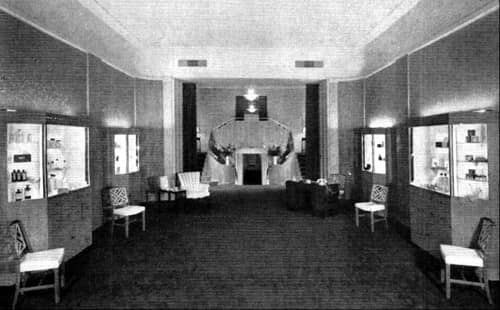
Above: 1937 Cyclax salon at 7 East 53rd Street, New York, the only stand-alone Cyclax salon besides South Molton Street
The salon at South Molton street was also refurbished in 1934. This may have been when the curved windows that made up the shop front were installed.
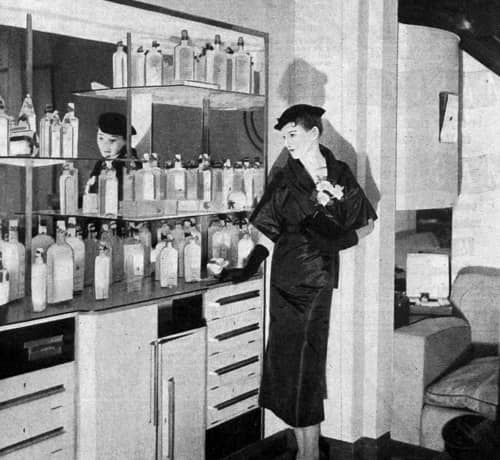
Above: 1934 Cosmetics display in the refurbished Cyclax salon in South Molton Street.
Other Cyclax salons were established around the world in the 1930s but these were situated in department stores or run by independant operators using Cyclax products.
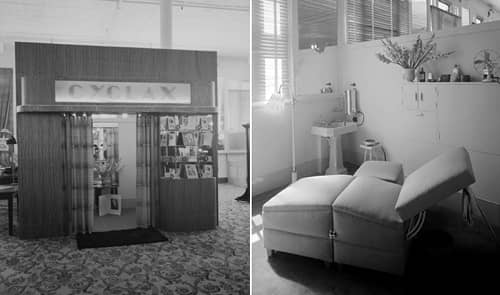
Above: 1938 Entrance and interior of a Cyclax salon in Boans, a department store in Perth, Western Australia (State Library).
To help boost sales the company also employed a number of travelling demonstrators who had been trained in London as international Cyclax representatives.

Above: 1929 Cyclax Travel Packs.
Skin-care
Cyclax skin-care treatments remained much as they were in the 1920s. The company continued to use skin foods to tone the flesh and keep it ‘firm and strong and round and young-looking’; massage and astringents to bring stretched muscles back to their normal state; and chin-straps in conjunction with Cyclax Muscle Restorer to ‘strengthen and brace relaxed muscles around the chin’.
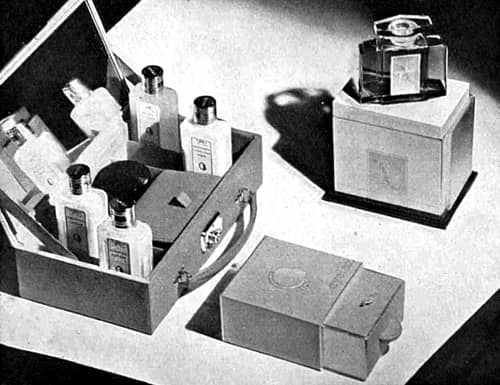
Above: 1936 Cyclax cosmetic case, De Lux Face Powder and La Cinquieme Nuit fragrance.
In addition to ‘feeding’ the skin, Cyclax still preached that a good complexion could be spoiled by dust and other impurities from without and by accumulated poisons from within.
These pores are actually the outlets of little ducts of glands which throw off the waste products of the blood—(which we usually classify roughly as perspiration or sweat). In other words, the pore of the outer skin is like a lock-gate which opens to let out the stream of impurities which the blood wants to get rid of. Clog up those tiny openings, those lock-gates, and the stream is checked. It turns back on itself and lies there stagnant. You have suffocated the dermis, the true skin …
Clogged pores mean more and more blemishes on the skin, they mean blackheads, spots, coarseness — all those poisoning evils which you naturally want to avoid.(Hemming, 1934, p. 33)
Skin acidity continued to be regarded as a major problem even though lactic acid rather than uric acid was now viewed as its main cause. It is worth noting that the company was still selling an antacid saline in the 1930s. It had been doing so from at least 1915, replacing an earlier recommendation to drink half-a-pint of Contrexéville Water before bed (The Cyclax Company, 1908, p. 14).
Antacid Saline: “One of the chief sources of skin imperfections is internal acid accumulation, and has too often been overlooked by beauty experts. The Cyclax Antacid Saline has been specially prepared for this condition, and is most beneficial.”
Cleansing the skin in the morning still required Cyclax Skin Soap and water rather than a cleansing cream or lotion to keep the pores clear. Cyclax did have Cyclax Cleansing Lotion in its skin-care range but this was used at night or during the day to prepare the skin for fresh make-up when soap and water was not readily available.
There are women, I know, who have become so used to creaming the face clean that they shudder at the brutal idea of using soap-and-water. Much too harsh, they say. They’re quite wrong. I can honestly say that I have never yet met a woman whose skin did not quickly improve under my soap-and-water treatment. When I think of one or two women I know who have not actually washed their faces for three or four years, it makes me feel almost as stifled and choked as their skin itself must feel.
(Hemming, 1934, p. 34)
Soap and water were effective in removing surface skin impurities but Cyclax still thought that problems coming from deeper in the dermis – like the previously mentioned acidities – could only be drawn out with Cyclax Special Lotion, the product retaining its iconic status within the company.
However scrupulously you may cream or wash your face everyday—your skin still secretes certain poisons that are beyond the reach of any ordinary cleansing, yet must be removed before your skin can breathe and function at its best. Cream and massage will loosen them; soap and water will wash much of them away. But only Cyclax Special Lotion will attract them—irresistibly as a magnet attracts iron; drawing every particle of impurity to the surface of your face, ready to be eased away with skin food before washing in the morning. One single application will free your skin of poisons that have been tiring it and worrying it for years, and once you skin is in a healthy condition a weekly application of the Lotion will be sufficient to carry on the good work. This essential cleansing is the basis upon which I have built my entire Cyclax Treatment.
(Cyclax advertisement, 1931)
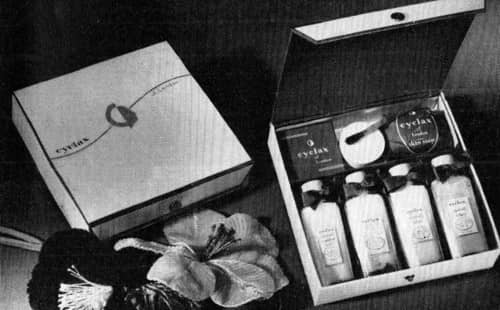
Above: 1939 A Cyclax Gift Set containing its most popular prewar treatments including Cleansing Lotion, Special Lotion, Cyclax Soap, Skin Food, Cyclax Powder and Braccine. The preparations are in the usual white and royal-coloured containers with the 1930s logo.
Skin types
Cyclax had long recognised oily (greasy), dry and sensitive skin types having introduced skin foods for each type back in 1915. However, as most Cyclax cleansing routines relied on soap and water, Cyclax did not have a range of skin cleansers or skin tonics based on skin type as was the case with most other cosmetic companies. This meant that the only major allowance made for skin types apart from skin foods was in the selection of a powder foundation.
Home treatments
Those clients who could not come to a Cyclax salon could follow the Cyclax Home Treatment Regime. Each evening, the face was washed with soap and water. Cyclax Special Lotion was then applied once a week with the other nights alternatively using Cyclax Skin Food and Cyclax Complexion Milk. In the morning, Cyclax Skin Food was massaged in before the face was washed with Cyclax soap and water to which a little Braceine skin tonic had been added.
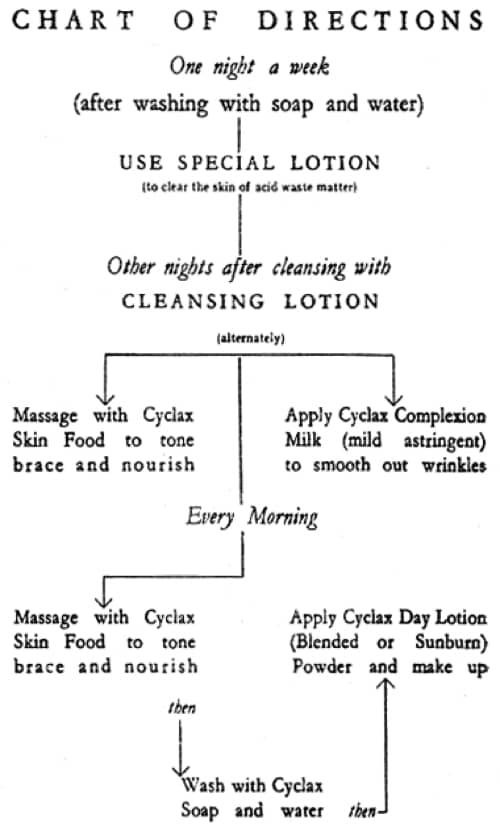
1934 Cyclax Treatment Chart (Hemming, 1934, p. 7)
Although most Cyclax representatives around the world followed this regime there were variations. One example follows:
A Guide to Cyclax
First, the pores of the skin must be cleansed and kept clean of all buried acids and dirt. Second the surface of the skin must be kept unclogged and clean by avoiding sticky cream and powder bases.
Begin this evening
At bedtime, wash your face with Cyclax soap and warm water then paint on one coat of Special Lotion. Let this dry for a minute or two, then paint on another coat. Smooth carefully with finger-tips.
First thing next morning
Overnight the Lotion will have drawn out every particle of acid and all impurities can gently be sponged away. Then massage with Cyclax Skin Food.
Before washing your face
During your bath the steam will open your pores and help the Skin Food complete its gentle, unforced cleansing. Soap and water cleanliness is an essential part of the Cyclax system.
Cyclax soap and water
Soap is almost a beauty treatment in itself. And always use Cyclax Oatmeal water-softener, it renders the hardest water soft.
Keeping the pores clean
Braceine in the rinsing water gives a delightful tingling coldness and safely closes the clean pores. Now your face is immaculately clean.
Before powdering
Pat on a little Cyclax Powder-Base. Smooth it in evenly, then take a soft towel and pat your face all over.
And finally, make up
Add rouge and powder. Your skin will have a finish that no greasy cream or heavy liquid mask can give. Cyclax Rouge and Powder cling naturally.(Cyclax advertisement, 1934)
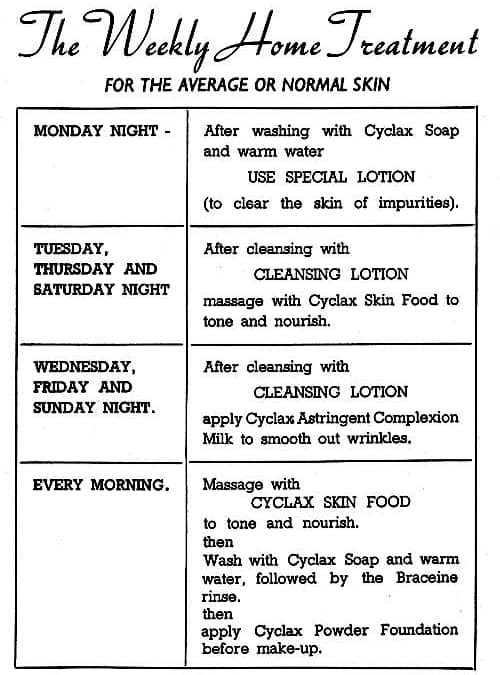
c.1938 Cyclax Weekly Home Treatment Chart (Mayle, p. 5)
Make-up
Considerable improvements were made in the Cyclax make-up range during the 1930s, reflecting the increasing acceptance of making up during the decade. Some lines were rationalised, new forms of make-up were introduced and shade ranges were increased considerably.
Foundations
After the skin was cleansed and otherwise prepared, a lotion was applied as a foundation for the face powder, with excess being removed with a soft towel. Cyclax continued to prefer lotions over creams when formulating its foundations, regarding creams as a make-up ‘deathtrap’.
And of course that greasy cream is a deathtrap for your make-up. Go into a hot room, or become warm with exercise (even a good argument will send up your temperature) and the cream quietly but persistently leaks through and just ruins your make-up. Creaming the face clean means over-greasing the face. It means that the make-up is a very precarious affair, liable to dissolve into its component parts at awkward moments, like a Madame Tussaud’s wax figure in front of a fire.
(Hemming, 1934, pp. 37-38)
The two foundations – finishing lotions or day lotions – Cyclax commonly recommended were Sunburn Lotion for dry or normal skins and Blended Lotion for greasy skins.
Despite its name, Sunburn Lotion was an all-weather cosmetic rather than a sun protectant and the name became increasingly problematic as suntanning became more common and Cyclax increased its range of suntanning cosmetics. In 1937, the company belatedly confronted this problem, renaming and/or reformulating the Sunburn Lotion as Cyclax Day Lotion. Blended Lotion, originally made by from a combination of Sunburn Lotion and Salusta Lotion continued as before. Both foundations came in shades that were matched with Cyclax Face Powder. By 1937, these were Light Rachel, Dark Rachel, Medium Rachel, Peach, Peach Bronze, English Peach, Naturelle, Ocre Rose, Sunbrown, Sunbrown 2 and Sunbrown 3.
Women with particularly dry or sensitive skin were recommended to use Cyclax Special Day lotion or Cyclax Milk of Roses as a foundation. The Special Day Lotion was abandoned within a few years, leaving Cyclax Milk of Roses, an emollient lotion, as the sole recommendation for sensitive skin types after the war. Unlike the other Cyclax day lotions it was not coloured so was also advertised for use in a ‘natural’ make-up. The company also recommended it for dry hands. Its status would rise even further after the war when it was rebranded as a moisturiser.
Milk of Roses: “As an alternative to the liquid powder base, there is the Milk of Roses, Emollient Lotion, which is also a liquid. Being light in consistency, it gives your skin sufficient moistness to hold the powder, then dries off immediately, giving a non-greasy finish.“
Problem areas such as the nose could be treated with Cyclax Antishine Cream or Cyclax Antishine Powder before applying face powder and, if a greater covering power was required, there was a thicker Cyclax Foundation Cream.
Foundation Cream: “A powder cream for evening use, for covering spots and giving a satin smooth appearance to the arms and neck.“
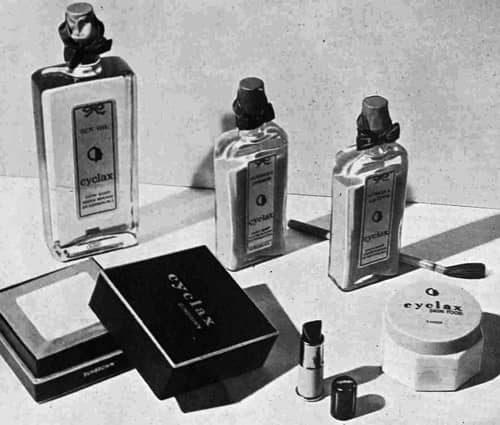
Above: 1935 Cyclax Sun Oil, Sunburn Lotion, Special Lotion, Face Powder, Lipstick and Thick Skin Food. Note that the Sunburn Lotion and Special Lotion are powder suspensions.
Face powder
In the 1930s, Cyclax sold two grades of face powder, Standard and Superfine. Surprisingly, they do not appear to have been differentiated by price. Each powder came in a range of shades with more dark shades introduced as the decade progressed and suntanning became more common. By 1937, the powders came in Light Rachel, Medium Rachel, Dark Rachel, Ocre, Rose, Peach, Peach Bronze, Flesh, Banana, Naturelle, Sunbrown, Sunbrown 2, Sunbrown 3, Verte, and Mauve shades with Rose Rachelle and Romany Tan added in 1938 and Pale Peach in 1939.
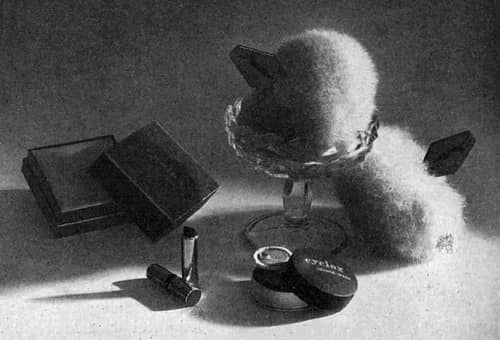
Above: 1933 Cyclax Face Powder, Lipstick and Rouge along with swansdown puffs.
Sun products
Despite its name Cyclax Sunburn Lotion was used more as a powder foundation than as a sun protectant and renaming it Cyclax Day Lotion in 1937 resolved a point of confusion.
By 1938, Cyclax sold three products for women going to the beach. Cyclax Sun Oil for those who wanted to tan and Cyclax Sunproof Cream and Cyclax Sunproof Oil for those who did not. Although it could be used on the arms and legs, the Sunproof Cream was used primarily on the face while the Sunproof Oil was to be liberally applied over the body.
Sun Oil: “For tanning without tears.”
Sunproof Cream: “It contains a protecting agent which completely prevents the sun’s rays from affecting the skin, and it gives a matt finish that is so attractive that it serves as a powder foundation.”
Sunproof Oil: “For those wishing to retain their
natural fairness of skin. Keeps the skin smooth and white.”
Women who wanted a darker skin tone without resorting to suntanning could use Cyclax Beauty Bronze Cream introduced in 1934.
Beauty Bronze: “A perfect simulated tan for the arms and legs if your skin doesn’t take kindly to the real thing.” Shades: Light, Dark and Evening.
The shades range altered during the decade becoming Sunbrown, Deep Sunbrown and Evening by 1936 and Light, Dark Romany Tan, Sunbrown and Evening in 1938.

Above: 1938 Cyclax Sunproof Cream, Romany Tan Make-up and Beauty Bronze.
Lipsticks
During the 1930s, Cyclax continued to make Cyclax Labyl, a lip protectant, and Cyclax Lipsticks. Cyclax Labyl came in a more limited shade range than the lipsticks and seems to have been discontinued either just before or during the war. By 1936, Cyclax Labyl came in Coral, Orange and Dark shades, later increased with the addition of Red Dust (1937), Pink Clover (1938) and Romany Tan (1938), while Cyclax Lipstick shades were Coral, Capucine, Orange, Mid-Brunette, Suntan, Brunette, Sunbrown and Carnation with Brilliant (1937), Red Dust (1937), Pink Clover (1938), Romany Tan (1938) and English Rose (1939) added before the war. The lipsticks were sold in two cases, a two-toned mauve case and a gilt de luxe case that came in a box.
Rouge
Cyclax continued to produced powder, compact and cream rouges it had introduced before 1930, recommending that rouge be applied under a foundation unless Milk of Roses was used.
Cyclax Powder Rouge and Compact Rouge came in Bloom of Nature, Capucine, Carnation, Coral, Orange, Mid-Brunette, Geranium, Sunbrown, Vieux Rose, Rose Clair, Rouge Indien and Confusion shades. Cyclax Cream Rouge had a similar shade range but for some reason Bloom of Nature was called Brunette. Towards the end of the decade, two more shades were added to match new lipstick colours – Pink Clover (1938), and Romany Tan (1938).
Eye make-up
In the 1920s Cyclax eye make-up was restricted to a type of mascara called Cyclax Lustrozene. It came in two forms, a liquid and a paste. It is possible that the paste form was originally sold as a cream mascara but by the 1930s it was definitely made as a cake. Originally made in Brown and Black shades, by the end of the 1930s it came in Light Brown, Medium Brown, Dark Brown, Dark Blue and Black. By 1937, the company was referring to it as a mascara by which time they were also selling an Eyebrow Pencil in Black and Brown shades.
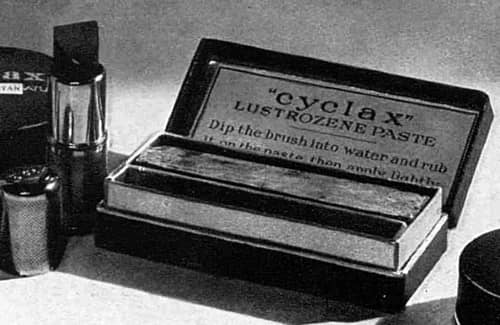
Above: 1937 Cyclax Paste Lustrozene.
By 1935, the company had also introduced an eye shadow, Cyclax Eyelid Cream. It came in a wide shade range going from Powder-Blue through to Gold and Silver. Applied with a finger it was worked from the centre of the eyelid out, making sure that were no hard demarkation lines.
Eyelid Cream: “[T]o accentuate the beauty of the eyes and enhance their charm.” Shades: Powder-Blue, Dark-Blue, Silver-Blue, Almond-Green, Bronze-Green, Gold-Green, Purple-Brown, Grey, Purple, Gold and Silver.
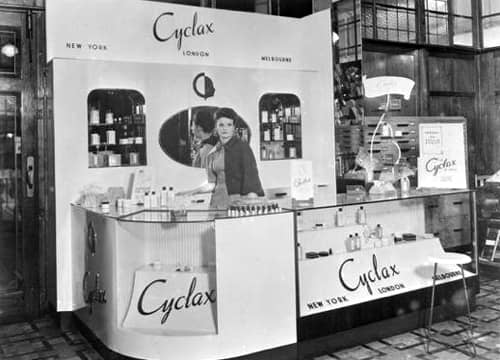
Above: Cyclax counter in a New Zealand department store.
Nail polish
As far as I can tell Cyclax did not introduce its Cyclax Nail Enamel until the 1930s but it was certainly no later than 1933. During the 1930s, nail polish underwent a shift from transparent forms coloured with dyes to cream forms made with opaque pigments. Both types could also be made iridescent by adding pearl powders or powdered metals, a practice that was widespread in the 1920s. By 1937, Cyclax was selling all three types of nail polish – transparent, cream and iridescent – each in a different shade range along with a nail polish remover.
Nail Enamel: “Emblazon your fingertips.”
Transparent Shades: Colourless, Naturelle, Rose, Carnation, Coral, Ecarlate, Ruby and Deep Ruby.
Cream Shades: Coral, Carnation, Ruby, Ecarlate and Rust.
Iridescent Shades: Silver, Pearl, Rose-Pearl and Bronze.
See also: Nail Polishes/Enamels
Colour coordination
Cyclax followed the familiar pattern of coordinating its foundations and face powders with the complexion, eye shadow with eye colour, and matching lipstick shades with rouge. Day make-up was subdued while evening make-up, under artificial light, could be more dramatic.
The fundamental note in Make-up for the day is moderation, and the coice of shades is controlled mainly by the natural skin colouring or “pigmentation.” At night, under artificial light, there is unlimited scope in colour selection. Whether you favour the glamorous and alluring, the brilliantly exotic, or the simple appeal of the delicately natural finish—personal choice is the deciding factor.
(Mayle, c.1938, p. 24)
The introduction of Cyclax Nail Enamel enabled the company to also match its lipsticks with its nail polishes, a fashionable trend in the 1930s and by the end of the decade, Cyclax was introducing new shades like Romany Tan that were colour matched across foundation, powder, lipstick, rouge and nail enamel.
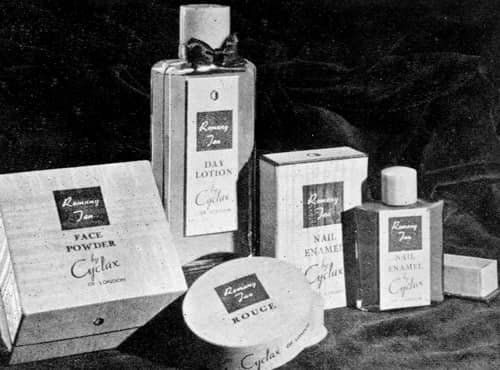
Above: 1938 Cyclax Romany Tan Face Powder, Day Lotion, Rouge, Nail Enamel and Lipstick.
Wartime
The onset of the Second World War began a difficult period for Cyclax. European outlets in Germany and France were cut off and there were the inevitable war shortages and quotas on production. Cosmetics in Britain also became subject to heavy taxation to help pay for the war and reduce demand on non essentials.
A number of lines were abandoned due to shortages of raw materials. Most noticeably, by 1940, Cyclax had ceased making its Nail Enamel. Those cosmetics that were available were subject to quotas and were sold in wartime packaging mostly made from cardboard. Women were told to save their prewar containers so that they could be reused.
The factory in Tottenham Court Road was destroyed during the London Blitz so the production of Cyclax cosmetics in Britain was moved, first to the family home in Sonning, Berkshire, then to a rented factory space in Ledbury Road, with perfume manufacturing carried on at the Potter & Moore factory in Seymour Road, Leyton. Fortunately, the shop at 58 South Molton Street was not damaged.
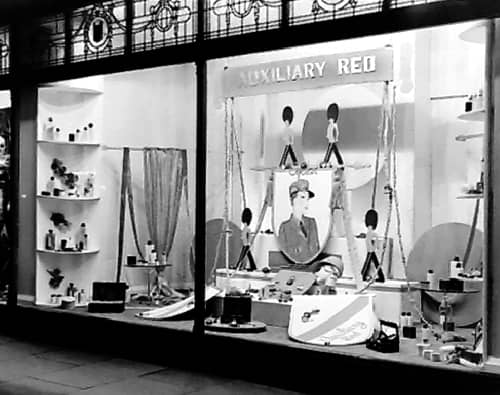
Above: Cyclax window display for Auxillary Red.
In 1939, Cyclax developed a new shade called Auxiliary Red in Cyclax Lipstick, Rouge and Nail Enamel, specifically designed for service women. Many believe it started the trend for the bright red lipsticks commonly seen during the war. In 1940, Cyclax added Velvet Grape for service women who wore black or navy.
Cyclax made a direct contribution to the war effort in a number of ways. The company developed a lotion for the treatment of burns, a sunproof cream for soldiers fighting in hot climates and a camouflage cream for the British army.
The camouflage cream – reputedly developed by Thelma Holland – was used as a base for Cyclax Stockingless Cream (1940), a cosmetic substitute for stockings. Applied by women to colour their legs, it came with a Cyclax Eyebrow Pencil which women could use to draw a line down the back of each leg, mimicking the seam present in stockings of the time.
Stockingless Cream: “Bare-leg freedom with the elegance of sheer hose. Non-greasy, nontacky; will not mark skirt or shoes. Non-staining to the skin; quickly removed with soap and water.” Shades: Mistbeige, Rosebeige, Honeybeige and Moondust.
See also Cosmetic Stockings
The war appears to have led to greater independence in the Cyclax overseas subsidiaries where restrictions on manufacturing were not as severe as they were in Britain. For example, the Australian subsidiary seems to have developed a new hand cream, called Demulcent Cream to help women engaged in manual work for the war effort.
Demulcent Cream: “[S]oothes roughened skin, to the softness of childhood. Petal-tinted, gently perfumed, it is fastidiously hand-made, and despite its richness is non-greasy.”
The United States did not enter the war until December, 1941, so the Cyclax company based there did not face the shortages experienced by Britain and the dominions in the early years of the war and this appears to have enabled the American branch to offer its customers a wider range of make-up shades.
Timeline
| 1934 | South Molton Street salon refurbished. New Products: Beauty Bronze Cream. |
| 1935 | Cyclax (Australia) Ltd. established in Melbourne, Australia. |
| 1936 | Cyclax of London, Inc. established in New York. |
| 1937 | New York salon opened at 7 East 53rd Street. New Products: Day Lotion. |
| 1938 | Cyclax (S.A.) Ltd. established in Johannesburg, South Africa. New Products: Sunproof Cream. |
| 1939 | Cyclax (N.Z.) Ltd. established in Wellington, New Zealand. New Products: Skin Tonic. |
| 1940 | New Products: Stockingless Cream. |
| 1941 | New Products: Demulcent Cream. |
| 1942 | Cyclax factory in Tottenham Court Road bombed. |
Continue to: Cyclax (post 1945)
First Posted: 12th March 2011
Last Update: 2nd November 2020
Sources
The chemist and druggist. (1859-) London: Morgan Brothers.
Gunn, F. (1973). The artificial face: A history of cosmetics. London: David & Charles.
Hemming, F. (1934). Towards beauty: Handbook for the would-be lovely [Booklet]. London: The Cyclax Company.
Manufacturing chemist. (1937-2012). London: Miller Freeman [etc.].
Mayle, L. (Ed.). (c.1938). The art of being lovely (4th ed.) [Booklet]. London: The Cyclax Company.
Mayle, L. (Ed.). (c.1943). The art of being lovely [Booklet]. USA: Cyclax of London.
Perfumery and essential oil record. (1910-1969). London: G. Street & Co., Ltd.
SPC. Soap, perfumery & cosmetics. (1935-1970). London: London Trade Press Ltd.
Wykes-Joyce, M. (1961). Cosmetics and adornment: Ancient and contemporary usage. London: Peter Owen.

Frances (Fanny) Lester [1872-1934], nee Frances Forsythe, nee Frances Hamilton, a.k.a. Mrs. Frances Hemming.
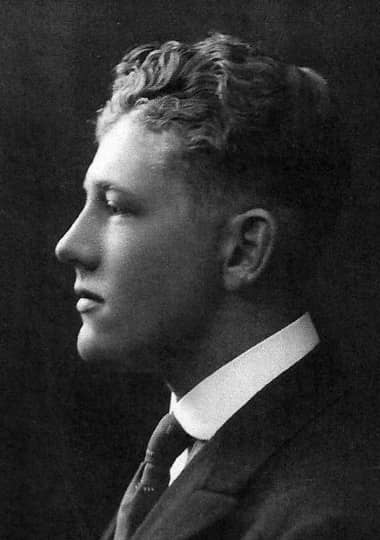
Gery Hamilton Forsythe [1896-1964] aged 20.
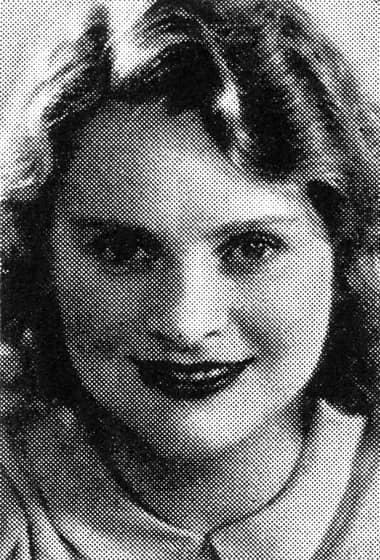
Lillian Mayle.
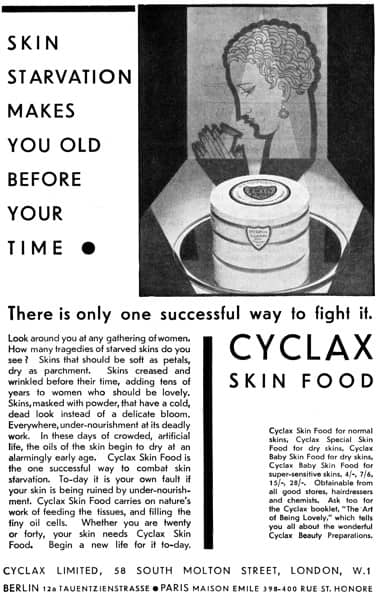
1930 Cyclax Skin Food. This advertisement is a variant on the usual argument that accompany skin foods by suggesting that crowded, artificial life is somehow responsible for drying out the oils of the skin.

1930 Cyclax.
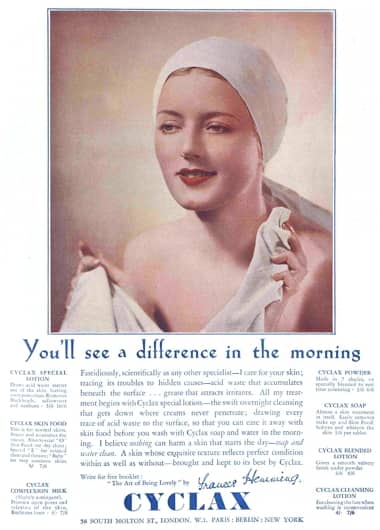
1931 Cyclax Special Lotion, Skin Food, Complexion Milk. Powder, Soap, Blended Lotion and Cleansing Lotion.

1931 Cyclax Special Lotion.

1931 Cyclax cleansing routine.

Robertson Brain [b.1892] married Frances in Manhattan in 1932 shortly before her death.
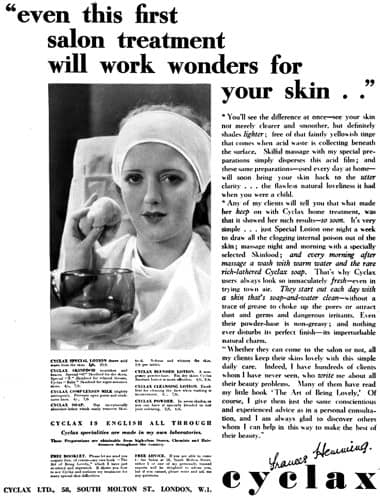
1932 Cyclax. Note the signature. It is unlikely that she had anything to do with the company by this stage. She died two years later.
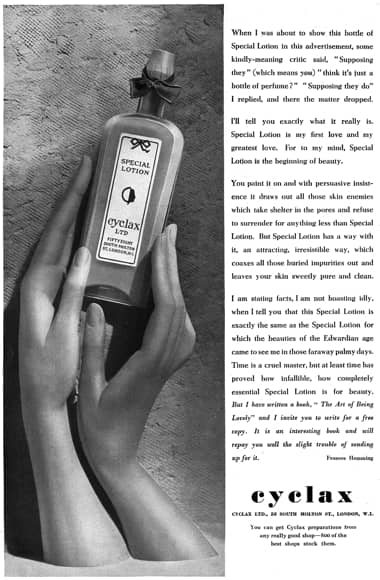
1933 Cyclax Special Lotion.

1935 Cyclax cosmetics, perfumes and cases.
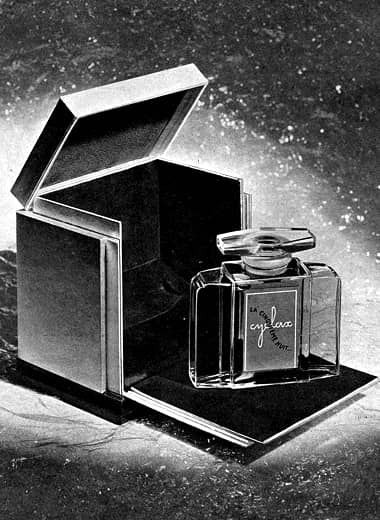
1935 Cyclax La Cinquieme Nuit. One of a number of perfumes introduced by Cyclax.
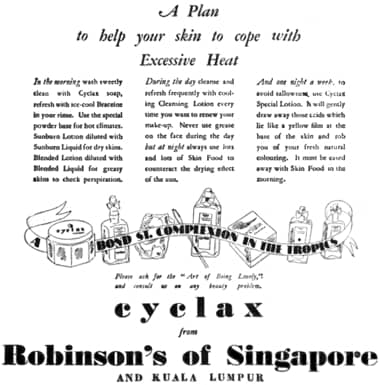
1936 Cyclax Bond Street Complexion in the Tropics.
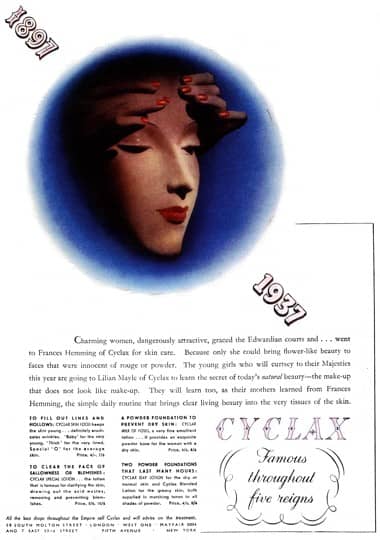
1937 Cyclax. Famous through five reigns celebrating the coronation of George VI. Cyclax would later provide advice for his daughter Elizabeth.
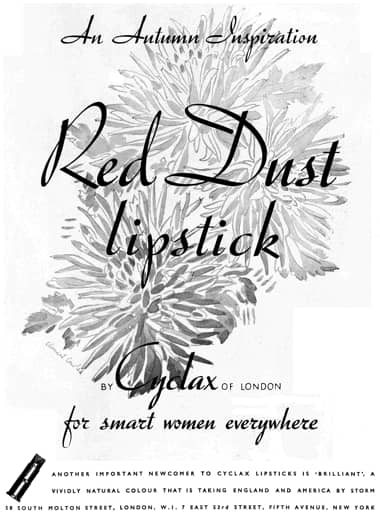
1937 Cyclax Red Dust.
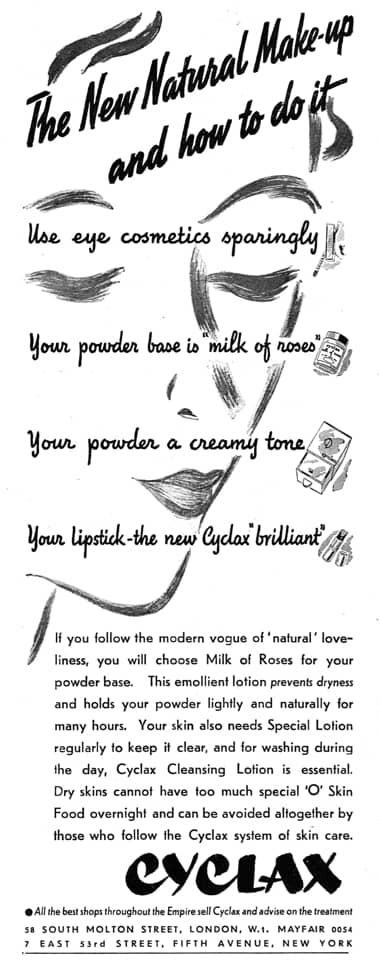
1937 Cyclax Natural Make-up using Cyclax Milk of Roses, a cream shade of Cyclax Face Powder, the Brilliant shade of Cyclax Lipstick and a little eye make-up.

1938 Cyclax salons in department stores around Australia.
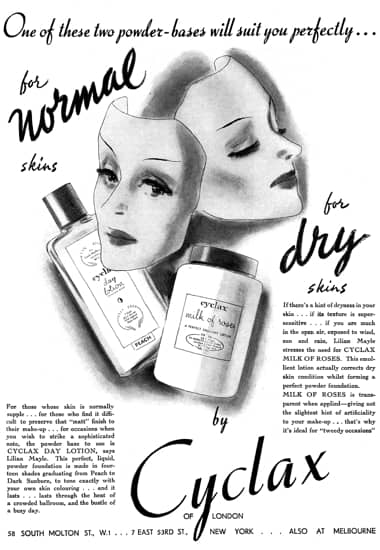
1938 Cyclax Day Lotion and Cyclax Milk of Roses.

1938 Cyclax Sunproof Cream, Cyclax Sunproof Oil, Cyclax Sun Oil and Cyclax Beauty Bronze.
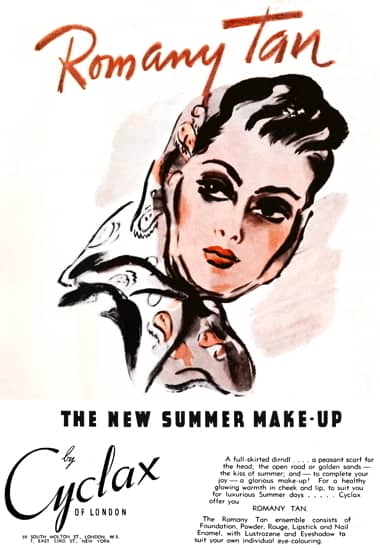
1938 Cyclax Romany Tan.

1939 Cyclax Special Lotion, Cyclax Soap, Cyclax Cleansing Lotion and Cyclax Skin Food.
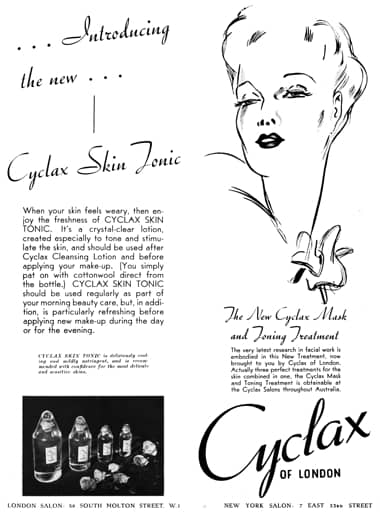
1939 Cyclax Skin Tonic. The product was a replacement for Cyclax Braceine. It appears to have been introduced as part of the Cyclax Mask and Toning Treatment introduced into Cyclax salons in 1939.
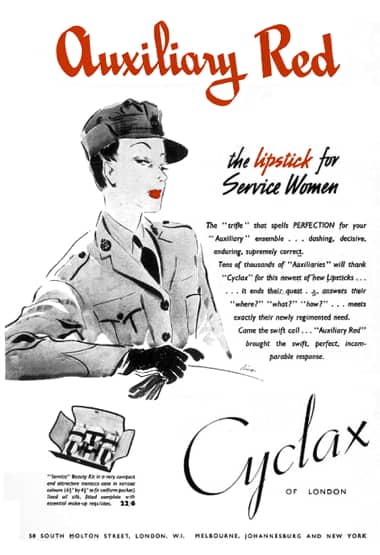
1939 Cyclax Auxiliary Red Lipstick. Auxiliary Red make-up included a rouge and nail enamel of the same name to be used with either Peach Bronze or Rose Rachel Cyclax Face Powder and Day Lotion.
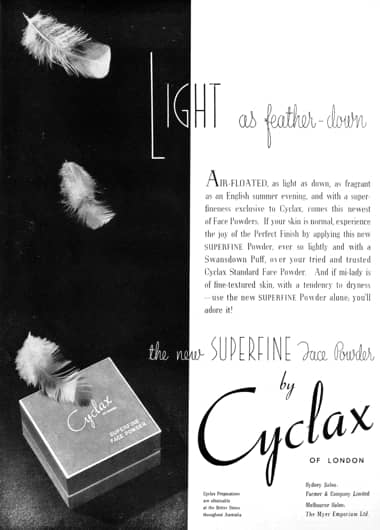
1940 Cyclax Superfine Face Powder.
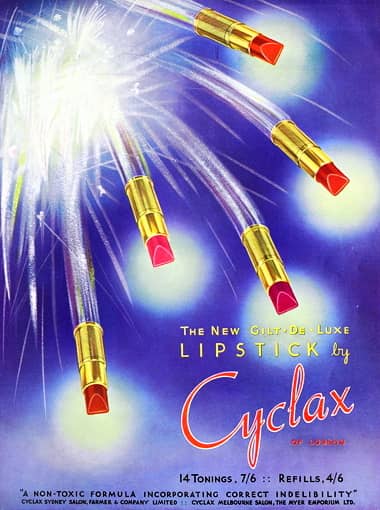
1940 Cyclax De Luxe Lipsticks.

1940 Cyclax Velvet Grape.

1940 Cyclax Milk of Roses.
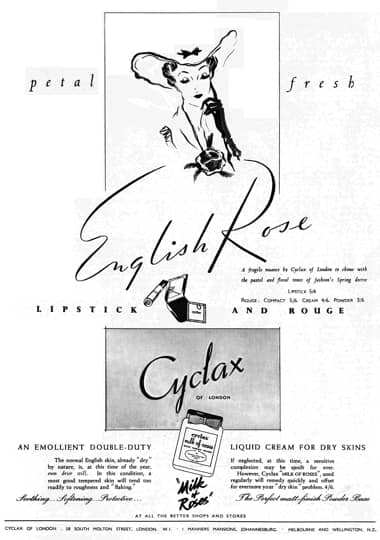
1940 Cyclax English Rose. When this shade was introduced in 1939 it also came in a Cyclax Nail Enamel but Cyclax stopped making nail polish soon after the war started.

1941 Cyclax Stockingless Cream.
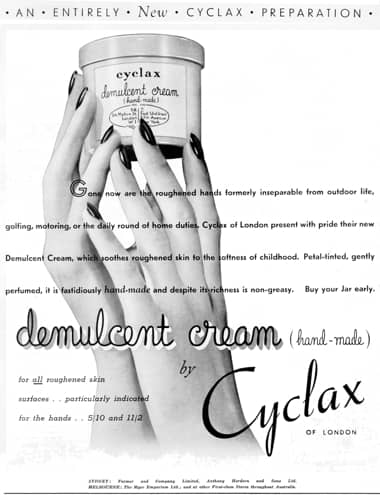
1941 Cyclax Demulcent Cream (Australia).
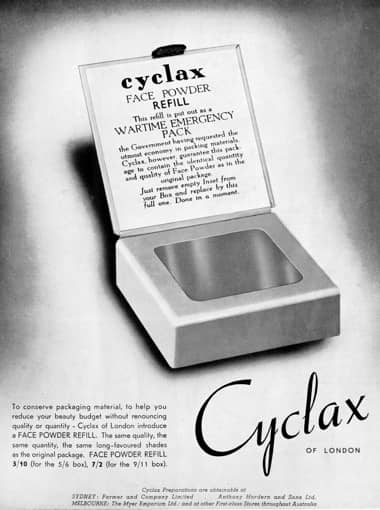
1942 Cyclax Wartime Emergency Pack.
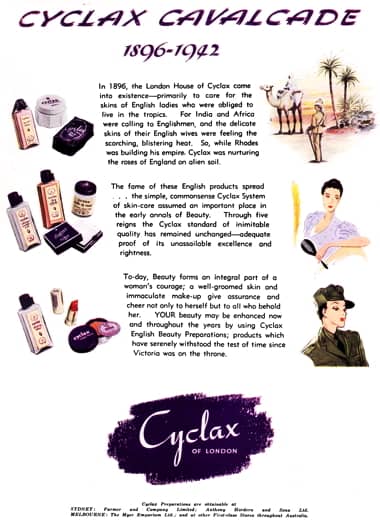
1942 Cyclax Cavalcade (Australia).
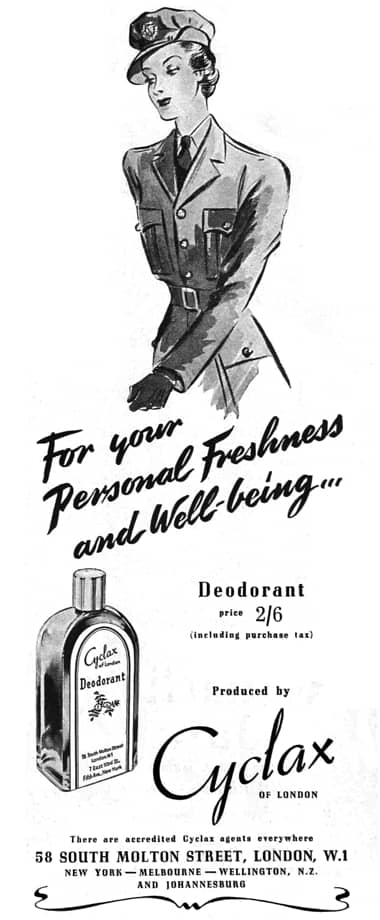
1942 Cyclax Deodorant.
